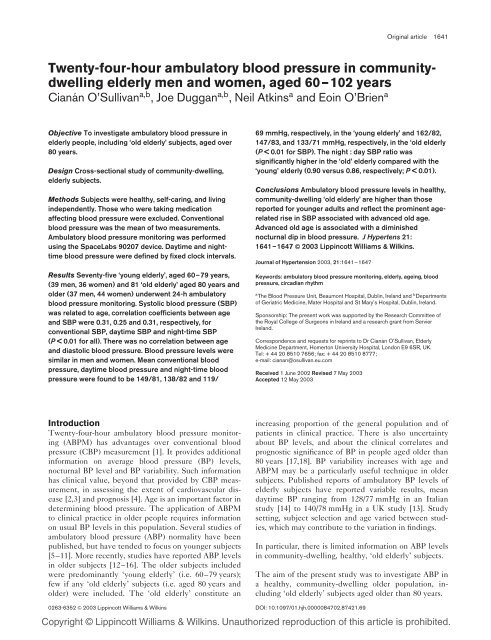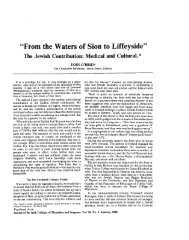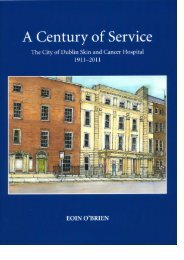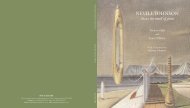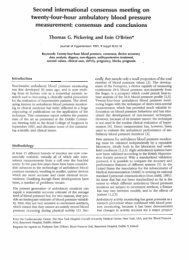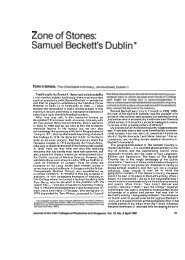Twenty-four-hour ambulatory blood pressure in ... - Eoin O'Brien
Twenty-four-hour ambulatory blood pressure in ... - Eoin O'Brien
Twenty-four-hour ambulatory blood pressure in ... - Eoin O'Brien
You also want an ePaper? Increase the reach of your titles
YUMPU automatically turns print PDFs into web optimized ePapers that Google loves.
<strong>Twenty</strong>-<strong>four</strong>-<strong>hour</strong> <strong>ambulatory</strong> <strong>blood</strong> <strong>pressure</strong> <strong>in</strong> communitydwell<strong>in</strong>g<br />
elderly men and women, aged 60–102 years<br />
Cianán O’Sullivan a,b , Joe Duggan a,b , Neil Atk<strong>in</strong>s a and Eo<strong>in</strong> O’Brien a<br />
Objective To <strong>in</strong>vestigate <strong>ambulatory</strong> <strong>blood</strong> <strong>pressure</strong> <strong>in</strong><br />
elderly people, <strong>in</strong>clud<strong>in</strong>g ‘old elderly’ subjects, aged over<br />
80 years.<br />
Design Cross-sectional study of community-dwell<strong>in</strong>g,<br />
elderly subjects.<br />
Methods Subjects were healthy, self-car<strong>in</strong>g, and liv<strong>in</strong>g<br />
<strong>in</strong>dependently. Those who were tak<strong>in</strong>g medication<br />
affect<strong>in</strong>g <strong>blood</strong> <strong>pressure</strong> were excluded. Conventional<br />
<strong>blood</strong> <strong>pressure</strong> was the mean of two measurements.<br />
Ambulatory <strong>blood</strong> <strong>pressure</strong> monitor<strong>in</strong>g was performed<br />
us<strong>in</strong>g the SpaceLabs 90207 device. Daytime and nighttime<br />
<strong>blood</strong> <strong>pressure</strong> were def<strong>in</strong>ed by fixed clock <strong>in</strong>tervals.<br />
Results Seventy-five ‘young elderly’, aged 60–79 years,<br />
(39 men, 36 women) and 81 ‘old elderly’ aged 80 years and<br />
older (37 men, 44 women) underwent 24-h <strong>ambulatory</strong><br />
<strong>blood</strong> <strong>pressure</strong> monitor<strong>in</strong>g. Systolic <strong>blood</strong> <strong>pressure</strong> (SBP)<br />
was related to age, correlation coefficients between age<br />
and SBP were 0.31, 0.25 and 0.31, respectively, for<br />
conventional SBP, daytime SBP and night-time SBP<br />
(P < 0.01 for all). There was no correlation between age<br />
and diastolic <strong>blood</strong> <strong>pressure</strong>. Blood <strong>pressure</strong> levels were<br />
similar <strong>in</strong> men and women. Mean conventional <strong>blood</strong><br />
<strong>pressure</strong>, daytime <strong>blood</strong> <strong>pressure</strong> and night-time <strong>blood</strong><br />
<strong>pressure</strong> were found to be 149/81, 138/82 and 119/<br />
Introduction<br />
<strong>Twenty</strong>-<strong>four</strong>-<strong>hour</strong> <strong>ambulatory</strong> <strong>blood</strong> <strong>pressure</strong> monitor<strong>in</strong>g<br />
(ABPM) has advantages over conventional <strong>blood</strong><br />
<strong>pressure</strong> (CBP) measurement [1]. It provides additional<br />
<strong>in</strong>formation on average <strong>blood</strong> <strong>pressure</strong> (BP) levels,<br />
nocturnal BP level and BP variability. Such <strong>in</strong>formation<br />
has cl<strong>in</strong>ical value, beyond that provided by CBP measurement,<br />
<strong>in</strong> assess<strong>in</strong>g the extent of cardiovascular disease<br />
[2,3] and prognosis [4]. Age is an important factor <strong>in</strong><br />
determ<strong>in</strong><strong>in</strong>g <strong>blood</strong> <strong>pressure</strong>. The application of ABPM<br />
to cl<strong>in</strong>ical practice <strong>in</strong> older people requires <strong>in</strong>formation<br />
on usual BP levels <strong>in</strong> this population. Several studies of<br />
<strong>ambulatory</strong> <strong>blood</strong> <strong>pressure</strong> (ABP) normality have been<br />
published, but have tended to focus on younger subjects<br />
[5–11]. More recently, studies have reported ABP levels<br />
<strong>in</strong> older subjects [12–16]. The older subjects <strong>in</strong>cluded<br />
were predom<strong>in</strong>antly ‘young elderly’ (i.e. 60–79 years);<br />
few if any ‘old elderly’ subjects (i.e. aged 80 years and<br />
older) were <strong>in</strong>cluded. The ‘old elderly’ constitute an<br />
69 mmHg, respectively, <strong>in</strong> the ‘young elderly’ and 162/82,<br />
147/83, and 133/71 mmHg, respectively, <strong>in</strong> the ‘old elderly<br />
(P < 0.01 for SBP). The night : day SBP ratio was<br />
significantly higher <strong>in</strong> the ‘old’ elderly compared with the<br />
‘young’ elderly (0.90 versus 0.86, respectively; P < 0.01).<br />
Conclusions Ambulatory <strong>blood</strong> <strong>pressure</strong> levels <strong>in</strong> healthy,<br />
community-dwell<strong>in</strong>g ‘old elderly’ are higher than those<br />
reported for younger adults and reflect the prom<strong>in</strong>ent agerelated<br />
rise <strong>in</strong> SBP associated with advanced old age.<br />
Advanced old age is associated with a dim<strong>in</strong>ished<br />
nocturnal dip <strong>in</strong> <strong>blood</strong> <strong>pressure</strong>. J Hypertens 21:<br />
1641–1647 & 2003 Lipp<strong>in</strong>cott Williams & Wilk<strong>in</strong>s.<br />
Journal of Hypertension 2003, 21:1641–1647<br />
Keywords: <strong>ambulatory</strong> <strong>blood</strong> <strong>pressure</strong> monitor<strong>in</strong>g, elderly, age<strong>in</strong>g, <strong>blood</strong><br />
<strong>pressure</strong>, circadian rhythm<br />
a The Blood Pressure Unit, Beaumont Hospital, Dubl<strong>in</strong>, Ireland and b Departments<br />
of Geriatric Medic<strong>in</strong>e, Mater Hospital and St Mary’s Hospital, Dubl<strong>in</strong>, Ireland.<br />
Sponsorship: The present work was supported by the Research Committee of<br />
the Royal College of Surgeons <strong>in</strong> Ireland and a research grant from Servier<br />
Ireland.<br />
Correspondence and requests for repr<strong>in</strong>ts to Dr Cianán O’Sullivan, Elderly<br />
Medic<strong>in</strong>e Department, Homerton University Hospital, London E9 6SR, UK.<br />
Tel: + 44 20 8510 7656; fax: + 44 20 8510 8777;<br />
e-mail: cianan@osullivan.eu.com<br />
Received 1 June 2002 Revised 7 May 2003<br />
Accepted 12 May 2003<br />
<strong>in</strong>creas<strong>in</strong>g proportion of the general population and of<br />
patients <strong>in</strong> cl<strong>in</strong>ical practice. There is also uncerta<strong>in</strong>ty<br />
about BP levels, and about the cl<strong>in</strong>ical correlates and<br />
prognostic significance of BP <strong>in</strong> people aged older than<br />
80 years [17,18]. BP variability <strong>in</strong>creases with age and<br />
ABPM may be a particularly useful technique <strong>in</strong> older<br />
subjects. Published reports of <strong>ambulatory</strong> BP levels of<br />
elderly subjects have reported variable results, mean<br />
daytime BP rang<strong>in</strong>g from 128/77 mmHg <strong>in</strong> an Italian<br />
study [14] to 140/78 mmHg <strong>in</strong> a UK study [13]. Study<br />
sett<strong>in</strong>g, subject selection and age varied between studies,<br />
which may contribute to the variation <strong>in</strong> f<strong>in</strong>d<strong>in</strong>gs.<br />
In particular, there is limited <strong>in</strong>formation on ABP levels<br />
<strong>in</strong> community-dwell<strong>in</strong>g, healthy, ‘old elderly’ subjects.<br />
The aim of the present study was to <strong>in</strong>vestigate ABP <strong>in</strong><br />
a healthy, community-dwell<strong>in</strong>g older population, <strong>in</strong>clud<strong>in</strong>g<br />
‘old elderly’ subjects aged older than 80 years.<br />
0263-6352 & 2003 Lipp<strong>in</strong>cott Williams & Wilk<strong>in</strong>s DOI: 10.1097/01.hjh.0000084702.87421.69<br />
Orig<strong>in</strong>al article 1641<br />
Copyright © Lipp<strong>in</strong>cott Williams & Wilk<strong>in</strong>s. Unauthorized reproduction of this article is prohibited.
1642 Journal of Hypertension 2003, Vol 21 No 9<br />
Methods<br />
The study protocol was approved by Beaumont Hospital<br />
Research Ethics Committee. Subjects were assessed<br />
by a research nurse or a physician, at the study centre,<br />
the Blood Pressure Unit, Beaumont Hospital. Subjects<br />
were recruited from local active-retirement associations,<br />
the local community and a general practitioner’s practice<br />
register. All were liv<strong>in</strong>g <strong>in</strong>dependently <strong>in</strong> the<br />
community. Subjects were healthy as def<strong>in</strong>ed by be<strong>in</strong>g<br />
ambulant, self-car<strong>in</strong>g, not limited by cardiovascular<br />
disease or tak<strong>in</strong>g vasoactive medication, and not limited<br />
by any other major illness. Additional health status<br />
details were obta<strong>in</strong>ed by questionnaire. A history of the<br />
follow<strong>in</strong>g conditions (as diagnosed by a physician) was<br />
sought: hypertension, heart attack, ang<strong>in</strong>a, stroke, transient<br />
ischaemic attack, cardiac failure, or peripheral<br />
arterial disease. Current drug treatment was also recorded.<br />
A history of hypertension was permitted if the<br />
subject was not on treatment. Weight, height and mid<br />
upper-arm circumference were measured. Subjects tak<strong>in</strong>g<br />
medication affect<strong>in</strong>g <strong>blood</strong> <strong>pressure</strong> were excluded.<br />
There were no <strong>blood</strong> <strong>pressure</strong> eligibility criteria, subjects<br />
found to be hypertensive were <strong>in</strong>cluded if they<br />
were not tak<strong>in</strong>g medication affect<strong>in</strong>g BP. BP was measured<br />
twice <strong>in</strong> the sitt<strong>in</strong>g position us<strong>in</strong>g a mercury<br />
sphygmomanometer, accord<strong>in</strong>g to the recommendations<br />
of the British Hypertension Society [19]. The mean of<br />
these two measurements was used as the CBP. The<br />
SpaceLabs 90207 (SpaceLabs, Redmond, Wash<strong>in</strong>gton,<br />
USA) <strong>ambulatory</strong> <strong>blood</strong> <strong>pressure</strong> monitor was then<br />
fitted to the non-dom<strong>in</strong>ant arm, us<strong>in</strong>g an appropriately<br />
sized cuff and programmed to record <strong>blood</strong> <strong>pressure</strong><br />
every 30 m<strong>in</strong> throughout the 24-h period, commenc<strong>in</strong>g<br />
between 0900 and 1200 h. This device has been<br />
previously validated [20]. Subjects were <strong>in</strong>structed to<br />
cont<strong>in</strong>ue normal daily activities, but to rest their arm at<br />
the times of BP measurement. Diaries were supplied,<br />
and subjects were asked to record activities, <strong>in</strong>clud<strong>in</strong>g<br />
bedtime and meal times.<br />
Data analysis<br />
<strong>Twenty</strong>-<strong>four</strong>-<strong>hour</strong> ABP record<strong>in</strong>gs were unedited. Daytime<br />
was def<strong>in</strong>ed as 0900–2100 h and night-time as<br />
0100–0600 h, and mean daytime BP and night-time BP<br />
levels were calculated for each <strong>in</strong>dividual. Record<strong>in</strong>gs<br />
with less than a m<strong>in</strong>imum of 16 daytime, six nighttime,<br />
or a total of 30 measurements were rejected. In<br />
calculat<strong>in</strong>g <strong>hour</strong>ly means, each BP measurement is<br />
taken to represent the measurements at each m<strong>in</strong>ute<br />
from 15 m<strong>in</strong> before to 15 m<strong>in</strong> after the actual read<strong>in</strong>g.<br />
The <strong>hour</strong>ly mean is the average of all representative<br />
read<strong>in</strong>gs occurr<strong>in</strong>g from the start of an <strong>hour</strong> to 59 m<strong>in</strong><br />
past the <strong>hour</strong>. This calculation is well def<strong>in</strong>ed, as an<br />
alteration <strong>in</strong> time of a particular read<strong>in</strong>g will at most<br />
have a marg<strong>in</strong>al effect on the average of two representative<br />
<strong>hour</strong>s. Data normality was checked us<strong>in</strong>g the<br />
Kolmogorov–Smirnov test. Normally distributed vari-<br />
ables were compared us<strong>in</strong>g Students t test or analysis of<br />
variance. The chi-square test was used to analyse<br />
categorical data and Pearson’s coefficient was used for<br />
correlation analysis. A value of P , 0.05 was considered<br />
significant for all tests. For analysis, the SPSS software<br />
package was used (SPSS Inc., Chicago, Ill<strong>in</strong>ois, USA).<br />
Results<br />
Subject characteristics<br />
A total of 156 subjects had complete 24-h ABPM<br />
record<strong>in</strong>gs, age range 60–102 years. There were 75<br />
‘young elderly’ aged 60–79 years (39 men, 36 women)<br />
and 81 ‘old elderly’ aged 80 years and older (37 men,<br />
44 women). Subject characteristics are presented <strong>in</strong><br />
Table 1. Ten subjects, five ‘young elderly’ and five ‘old<br />
elderly’, reported a history of cardiovascular disease.<br />
Age, subject characteristics and BP levels were similar<br />
<strong>in</strong> these 10 subjects compared with subjects without a<br />
history of cardiovascular disease (data not shown).<br />
<strong>Twenty</strong>-two subjects reported be<strong>in</strong>g told <strong>in</strong> the past<br />
that their BP was elevated, <strong>four</strong> of whom had a history<br />
of cardiovascular disease.<br />
BP levels<br />
There was a positive association between age and<br />
systolic <strong>blood</strong> <strong>pressure</strong> (SBP). Correlation coefficients<br />
between age and SBP were 0.31, 0.25 and 0.31,<br />
respectively, for conventional SBP, daytime SBP and<br />
night-time SBP (P , 0.01 for all). There was no correlation<br />
between age and diastolic <strong>blood</strong> <strong>pressure</strong> (DBP),<br />
neither CBP nor <strong>ambulatory</strong> DBP. CBP and ABP<br />
results are presented <strong>in</strong> Table 1. Gender did not<br />
<strong>in</strong>fluence BP levels. Mean CBP, daytime BP and nighttime<br />
BP levels <strong>in</strong> the ‘young elderly’ were 149/81, 138/<br />
82 and 119/69 mmHg, respectively, and <strong>in</strong> the ‘old<br />
elderly’ BP levels were 162/82, 147/83, and 133/<br />
71 mmHg, respectively (P , 0.001, for SBP variables).<br />
There were no significant differences <strong>in</strong> conventional<br />
or <strong>ambulatory</strong> DBP between ‘young’ and ‘old’ elderly<br />
subjects. CBP and daytime BP were correlated, coefficients<br />
0.69/0.51 for SBP/DBP, respectively (P , 0.01<br />
for both).<br />
<strong>Twenty</strong>-two subjects (14%) reported a history of hypertension<br />
but were not tak<strong>in</strong>g treatment. These 22<br />
subjects were of similar age to the 134 subjects who did<br />
not report a history of hypertension, but had significantly<br />
higher BP levels, both CBP and ABP (Table 2).<br />
Age-related differences <strong>in</strong> SBP between ‘young elderly’<br />
and ‘old elderly’ subjects persisted, and rema<strong>in</strong>ed significant,<br />
when subjects with a history of hypertension<br />
were excluded.<br />
<strong>Twenty</strong>-<strong>four</strong>-<strong>hour</strong> BP profile<br />
<strong>Twenty</strong>-<strong>four</strong>-<strong>hour</strong> BP and heart rate profiles are shown<br />
<strong>in</strong> Figures 1 and 2. In addition to the nocturnal dip <strong>in</strong><br />
BP, a mid-afternoon dip <strong>in</strong> <strong>blood</strong> <strong>pressure</strong> with a nadir<br />
Copyright © Lipp<strong>in</strong>cott Williams & Wilk<strong>in</strong>s. Unauthorized reproduction of this article is prohibited.
Table 1 Subject characteristics and <strong>blood</strong> <strong>pressure</strong> levels<br />
at 1400 h was evident, especially <strong>in</strong> the old elderly<br />
subjects. Unlike the nocturnal dip <strong>in</strong> BP, the midafternoon<br />
dip <strong>in</strong> BP was not accompanied by a decl<strong>in</strong>e<br />
<strong>in</strong> heart rate. Subjects who recorded meal times <strong>in</strong> their<br />
diaries <strong>in</strong>dicated that most subjects had their ma<strong>in</strong> meal<br />
between 1200 and 1330 h and a lighter meal <strong>in</strong> the<br />
even<strong>in</strong>g. The change <strong>in</strong> <strong>hour</strong>ly mean BP between<br />
1200 h (read<strong>in</strong>gs occurr<strong>in</strong>g between 1200 and 1259 h)<br />
and 1400 h (read<strong>in</strong>gs between 1400 and 1459 h) averaged<br />
4.1/3.7 and 16.9/8.5 <strong>in</strong> the ‘young’ and ‘old’<br />
elderly, respectively (P , 0.001/0.05 for SBP/DBP). In<br />
contrast, over the same period, heart rate changed little<br />
and non-significantly, with average <strong>in</strong>creases of 3 and<br />
1 beats/m<strong>in</strong> <strong>in</strong> the ‘young’ and ‘old’ subjects, respectively.<br />
The night-time dip <strong>in</strong> SBP was less prom<strong>in</strong>ent <strong>in</strong> the<br />
‘Young’ elderly (60–79 years) ‘Old’ elderly (80+ years) All subjects<br />
Men Women Men Women ‘Young’ elderly ‘Old’ elderly<br />
n 39 36 37 44 75 81<br />
CV history 3 2 1 4 5 5<br />
History of high <strong>blood</strong> <strong>pressure</strong> 5 5 3 9 10 12<br />
Age (years) 70 5 69 3 86 5 86 5 70 4 86 5<br />
Weight (kg) 80 9 65 9 68 10 58 10 73 12 62 + 11<br />
Height (cm) 177 7 161 5 169 7 155 8 169 10 161 10<br />
Body mass <strong>in</strong>dex (kg/m 2 ) 26 4 25 3 24 3 24 4 26 3 24 3<br />
Conventional SBP 148 20 150 18 158 23 164 26 149 19 162 24<br />
Conventional DBP 80 11 82 9 81 9 83 11 81 10 82 10<br />
Daytime SBP 139 16 136 14 146 18 148 19 138 15 147 19<br />
Daytime DBP 84 12 80 10 85 9 82 10 82 1 83 9<br />
Night-time SBP 121 17 117 14 131 19 133 23 119 15 133 22<br />
Night-time DBP 72 12 66 9 72 9 70 12 69 11 71 10<br />
SBP difference 9 17 14 16 12 14 17 18 11 17 15 16<br />
DBP difference –3 11 1 10 –4 8 0.8 11 –1 11 –1 9<br />
Night : day SBP y 0.87 0.09 0.86 0.07 0.90 0.09 0.90 0.1 0.86 0.08 0.90 0.09<br />
Night : day DBP y 0.86 0.1 0.82 0.08 0.85 0.08 0.85 0.1 0.84 0.09 0.85 0.09<br />
Day – night SBP 19 13 20 10 14 13 14 14 19 12 14 14<br />
Day – night DBP 12 10 15 7 13 7 12 9 13 9 13 8<br />
Data presented as mean standard deviation (mmHg) (rounded to nearest mmHg). y Data presented as ratio. SBP, systolic <strong>blood</strong> <strong>pressure</strong>; DBP, diastolic <strong>blood</strong><br />
<strong>pressure</strong>; CV, cardiovascular; difference, conventional – daytime <strong>blood</strong> <strong>pressure</strong> difference; day – night BP, day – night <strong>blood</strong> <strong>pressure</strong> difference. P , 0.05,<br />
P , 0.01, P , 0.001, compared with the ‘young’ elderly.<br />
Table 2 Blood <strong>pressure</strong> levels <strong>in</strong> subjects with and without a history of hypertension<br />
‘Young’ elderly (60–79 years) ‘Old’ elderly (80+ years)<br />
History of hypertension<br />
Ambulatory <strong>blood</strong> <strong>pressure</strong> <strong>in</strong> elderly and very elderly subjects O’Sullivan et al. 1643<br />
No history of<br />
hypertension History of hypertension<br />
No history of<br />
hypertension<br />
n 10 65 12 69<br />
Age (years) 69 5 70 4 84 3 86 5<br />
Conventional SBP 163 15 147 19 187 15 157 23<br />
Conventional DBP 90 7 79 10 91 7 80 10<br />
Daytime SBP 153 16 135 13 167 19 143 16<br />
Daytime DBP 92 13 81 10 88 7 82 10<br />
Night-time SBP 135 15 116 14 157 27 128 18<br />
Night-time DBP 77 8 68 11 78 11 69 10<br />
Data presented as mean standard deviation (mmHg) (rounded to nearest mmHg). y Data presented as ratio. SBP, systolic<br />
<strong>blood</strong> <strong>pressure</strong>; DBP, diastolic <strong>blood</strong> <strong>pressure</strong>. P , 0.05, P , 0.01, P , 0.001, history of hypertension versus no<br />
history of hypertension.<br />
older subjects, both <strong>in</strong> absolute terms (P , 0.05) and,<br />
relatively, the night : day ratio (P , 0.01) (Table 1).<br />
Distribution of ABP<br />
The distribution of ABP, the 5th and 95th percentiles,<br />
<strong>in</strong> ‘young’ and ‘old’ elderly subjects, when the subjects<br />
with a history of hypertension were excluded, is presented<br />
<strong>in</strong> Table 3. There was considerable variability<br />
<strong>in</strong> BP levels, especially <strong>in</strong> the ‘old elderly’ and hence a<br />
broad range of BP levels.<br />
Discussion<br />
The present study is a community-based <strong>in</strong>vestigation<br />
of ABP levels <strong>in</strong> elderly subjects, and <strong>in</strong>cluded 81<br />
subjects aged 80 years or older, the ‘old elderly’, who<br />
were not tak<strong>in</strong>g medication affect<strong>in</strong>g BP. This is the<br />
largest number of old elderly subjects <strong>in</strong>cluded <strong>in</strong> any<br />
Copyright © Lipp<strong>in</strong>cott Williams & Wilk<strong>in</strong>s. Unauthorized reproduction of this article is prohibited.
1644 Journal of Hypertension 2003, Vol 21 No 9<br />
Fig. 1<br />
mmHg (bpm)<br />
180.0<br />
150.0<br />
120.0<br />
90.0<br />
60.0<br />
30.0<br />
0.0<br />
8:00 10:00 12:00 14:00 16:00 18:00 20:00<br />
Time<br />
22:00 0:00 2:00 4:00 6:00<br />
Hourly mean <strong>blood</strong> <strong>pressure</strong> (mmHg, + 1 standard deviation) and heart rate (beats/m<strong>in</strong>, 1 standard deviation) <strong>in</strong> ‘young elderly’ subjects. Solid<br />
l<strong>in</strong>e represents <strong>blood</strong> <strong>pressure</strong>, broken l<strong>in</strong>e represents heart rate.<br />
Fig. 2<br />
mmHg (bpm)<br />
180.0<br />
150.0<br />
120.0<br />
90.0<br />
60.0<br />
30.0<br />
0.0<br />
8:00 10:00 12:00 14:00 16:00 18:00 20:00<br />
Time<br />
22:00 0:00 2:00 4:00 6:00<br />
Hourly mean <strong>blood</strong> <strong>pressure</strong> (mmHg, + 1 standard deviation) and heart rate (beats/m<strong>in</strong>, 1 standard deviation) <strong>in</strong> ‘old elderly’ subjects. Solid l<strong>in</strong>e<br />
represents <strong>blood</strong> <strong>pressure</strong>, broken l<strong>in</strong>e represents heart rate.<br />
Copyright © Lipp<strong>in</strong>cott Williams & Wilk<strong>in</strong>s. Unauthorized reproduction of this article is prohibited.
Table 3 Distribution of <strong>ambulatory</strong> <strong>blood</strong> <strong>pressure</strong><br />
such study to date. Two previous studies of ABP levels<br />
<strong>in</strong>clud<strong>in</strong>g subjects aged 80 years and older have been<br />
published [13,16]. Sample sizes were smaller (n ¼ 52<br />
and n ¼ 36, respectively) [13,16] than <strong>in</strong> the present<br />
study. The mean levels of ABP <strong>in</strong> the ‘young elderly’<br />
<strong>in</strong> the present study are similar to [11,15] or slightly<br />
higher than [6–9,12–14] <strong>in</strong> similarly aged subjects <strong>in</strong><br />
other studies. In the ‘old elderly’, mean BP levels <strong>in</strong><br />
the present study are consistently higher than <strong>in</strong> other<br />
studies of elderly subjects [12–16].<br />
There are a number of possible explanations for the<br />
differences <strong>in</strong> BP levels between the present study and<br />
some previous reports of ABP <strong>in</strong> older people. A<br />
contribut<strong>in</strong>g factor to the higher levels <strong>in</strong> the present<br />
study is the <strong>in</strong>clusion of subjects with a history of<br />
hypertension. Previous cross-sectional studies of ABP<br />
<strong>in</strong> the elderly excluded subjects with a history of<br />
hypertension, even if no longer receiv<strong>in</strong>g treatment,<br />
but did <strong>in</strong>clude subjects found to be hypertensive on<br />
entry [12,13]. It could be argued that such a design<br />
applies BP eligibility criteria <strong>in</strong>consistently and makes<br />
the study sample less representative of the population<br />
under <strong>in</strong>vestigation. The present study did not exclude<br />
anyone on the basis of past or current BP level. We<br />
sought to measure ABP <strong>in</strong> elderly people who were not<br />
subject to the two ma<strong>in</strong> confound<strong>in</strong>g <strong>in</strong>fluences on BP<br />
<strong>in</strong> old age: antihypertensive (or other vasoactive) medication,<br />
and ill-health. When subjects with a history of<br />
hypertension were excluded from the present study,<br />
ABP levels <strong>in</strong> the ‘young elderly’ were similar to levels<br />
reported <strong>in</strong> previous studies, and although BP levels <strong>in</strong><br />
the ‘old elderly’ were reduced they rema<strong>in</strong>ed higher<br />
than <strong>in</strong> previous reports [12–16]. Only two of these<br />
studies <strong>in</strong>cluded subjects aged older than 80 years and<br />
there were differences <strong>in</strong> subject selection and methods<br />
to the present study. The study by Fotherby and Potter<br />
[13] was of a similar northern European (British) population,<br />
although 45% of subjects were recruited from a<br />
hospital sett<strong>in</strong>g, either <strong>in</strong>-patients or from an out-patient<br />
cl<strong>in</strong>ic, whereas the present study was community<br />
based. In the latter study, which excluded subjects with<br />
a history of hypertension, there were 52 subjects aged<br />
older than 80 years, and mean CBP and daytime BP<br />
levels <strong>in</strong> ‘old elderly’ subjects were lower than <strong>in</strong> the<br />
present study but night-time BP levels were similar. In<br />
Ambulatory <strong>blood</strong> <strong>pressure</strong> <strong>in</strong> elderly and very elderly subjects O’Sullivan et al. 1645<br />
‘Young’ elderly (60–79 years) ‘Old’ elderly (80+ years)<br />
Mean 5th percentile 95th percentile Mean 5th percentile 95th percentile<br />
Daytime SBP 135 118 162 143 119 173<br />
Daytime DBP 81 66 105 82 68 101<br />
Night-time SBP 116 94 141 128 98 158<br />
Night-time DBP 68 53 88 69 54 87<br />
Data refers to 134 subjects without a history of hypertension. SBP, systolic <strong>blood</strong> <strong>pressure</strong>; DBP, diastolic <strong>blood</strong> <strong>pressure</strong>.<br />
the study by Bert<strong>in</strong>ieri et al., of a southern European<br />
(Italian) population, the comparable subjects (20 octogenarians)<br />
were selected to be normotensive, and BP<br />
levels were therefore lower than <strong>in</strong> the present study<br />
[16].<br />
Our f<strong>in</strong>d<strong>in</strong>gs can be expla<strong>in</strong>ed by a significant agerelated<br />
change <strong>in</strong> BP <strong>in</strong> old elderly people. Age-related<br />
changes <strong>in</strong> BP, such as the rise <strong>in</strong> SBP, were evident on<br />
compar<strong>in</strong>g the ‘young elderly’ with the ‘old elderly’ <strong>in</strong><br />
the present study. Stiffen<strong>in</strong>g of large arteries and<br />
decreased arterial compliance is a feature of age<strong>in</strong>g and<br />
causes a rise <strong>in</strong> SBP [21]. This age-related process<br />
would be expected to be most prom<strong>in</strong>ent <strong>in</strong> healthy old<br />
elderly people who are not subject to the confound<strong>in</strong>g<br />
<strong>in</strong>fluence of co-morbid illness on BP, such as the<br />
subjects <strong>in</strong> our study.<br />
The contention that the levels of ABP <strong>in</strong> the ‘old<br />
elderly’ subjects <strong>in</strong> the present study are a reflection of<br />
a prom<strong>in</strong>ent age-related rise <strong>in</strong> SBP <strong>in</strong> this age group is<br />
supported by epidemiological studies that have consistently<br />
reported high BP levels <strong>in</strong> elderly populations <strong>in</strong><br />
different countries, [15,22–24]. A recent Belgian population<br />
study found that almost one-half of a sample of<br />
818 people aged 75–89 years either had a measured<br />
conventional SBP <strong>in</strong> excess of 160 mmHg or were<br />
tak<strong>in</strong>g antihypertensive treatment [24]. A Swedish<br />
population-based study <strong>in</strong>volv<strong>in</strong>g 1800 elderly subjects,<br />
whose mean age was 83 years, which <strong>in</strong>cluded those<br />
tak<strong>in</strong>g medication affect<strong>in</strong>g BP, found that 44% of<br />
subjects had a conventional SBP <strong>in</strong> excess of 160<br />
mmHg [25]. CBP <strong>in</strong> 603 elderly people, whose mean<br />
age was 76 years, report<strong>in</strong>g no health problems and<br />
tak<strong>in</strong>g no medication, was found to be 160/86 mmHg <strong>in</strong><br />
a British study [26]. Furthermore when subjects <strong>in</strong> the<br />
latter study were followed up, those who rema<strong>in</strong>ed<br />
disease and medication free experienced a cont<strong>in</strong>ued<br />
rise <strong>in</strong> SBP over the succeed<strong>in</strong>g 7 years [27].<br />
On the other hand, the present study did not <strong>in</strong>clude<br />
all potentially eligible elderly and ‘old elderly’ subjects<br />
<strong>in</strong> the population. Less healthy, frail or non-community-dwell<strong>in</strong>g<br />
older people tend to have lower BP levels<br />
and such subjects were not <strong>in</strong>cluded <strong>in</strong> the present<br />
study. The subjects <strong>in</strong>cluded were healthy and liv<strong>in</strong>g<br />
Copyright © Lipp<strong>in</strong>cott Williams & Wilk<strong>in</strong>s. Unauthorized reproduction of this article is prohibited.
1646 Journal of Hypertension 2003, Vol 21 No 9<br />
<strong>in</strong>dependently, and there were no BP selection criteria.<br />
The results are therefore applicable to this population<br />
(i.e. healthy, free-liv<strong>in</strong>g elderly people).<br />
Some authors have reported gender differences <strong>in</strong> BP<br />
behaviour. In the Allied Irish Bank study, BP <strong>in</strong> men<br />
was consistently higher than <strong>in</strong> women, both CBP and<br />
ABP, although male–female differences did dim<strong>in</strong>ish<br />
with <strong>in</strong>creas<strong>in</strong>g age [6]. Although SBP <strong>in</strong> men tends to<br />
be higher than SBP <strong>in</strong> women from youth to middle<br />
age, <strong>in</strong> the elderly the situation reverses, with women<br />
hav<strong>in</strong>g higher SBP than men. Imai et al. reported that<br />
the age-associated rise <strong>in</strong> ABP was significantly higher<br />
for women than men and that nocturnal dip decl<strong>in</strong>ed<br />
with age <strong>in</strong> men but not women [8]. In the present<br />
study mean BP levels did not differ <strong>in</strong> men and<br />
women. The old elderly women did tend to have<br />
higher SBP than old elderly men, differences were<br />
small, and not statistically significant.<br />
A change <strong>in</strong> the circadian BP pattern with age has been<br />
postulated. An age-related lessen<strong>in</strong>g of the nocturnal<br />
dip has been reported <strong>in</strong> elderly men [8]. An absent<br />
nocturnal BP has been reported <strong>in</strong> very elderly women<br />
[13] and <strong>in</strong> centenarians [16]. In the present study<br />
mean night-time BP levels (both SBP and DBP) were<br />
consistently lower than mean daytime BP levels,<br />
although to a significantly lesser extent <strong>in</strong> the ‘old<br />
elderly’ compared with the ‘young elderly’. Our f<strong>in</strong>d<strong>in</strong>gs<br />
are consistent with an alteration <strong>in</strong> the circadian<br />
BP profile with a lessen<strong>in</strong>g of nocturnal dip with age.<br />
A fall <strong>in</strong> BP that is unaccompanied by a fall <strong>in</strong> heart<br />
rate is characteristic of postprandial hypotension. The<br />
elderly may be more susceptible to post-prandial hypotension<br />
[28]. In the present study, the ‘old elderly’<br />
subjects demonstrated a prom<strong>in</strong>ent mid-afternoon dip<br />
<strong>in</strong> BP, the tim<strong>in</strong>g of which and associated heart rate<br />
changes were characteristic of postprandial hypotension.<br />
The greater magnitude of this afternoon BP<br />
change <strong>in</strong> the old elderly is consistent with an agerelated<br />
susceptibility to postprandial hypotension.<br />
Thus, old age appears to be associated with two<br />
separate, and somewhat contradictory, changes <strong>in</strong> shortterm<br />
BP regulation: an attenuated nocturnal BP reduction,<br />
and an exaggerated post-prandial BP reduction.<br />
Our results are <strong>in</strong> agreement with a recent study of<br />
extreme old age (centenarians) that found a consistent<br />
post-prandial BP reduction despite an absent nocturnal<br />
BP reduction [16]<br />
Our study does have some limitations. Although subjects<br />
were generally healthy and nearly all were free of<br />
cl<strong>in</strong>ical cardiovascular disease (and other significant<br />
illness), they were not formally screened to exclude<br />
disease. It is possible that if screen<strong>in</strong>g had been undertaken,<br />
occult or undiagnosed disease may have been<br />
present. Consider<strong>in</strong>g the BP levels of the sample, it is<br />
possible that undiagnosed hypertensive target-organ<br />
damage was present <strong>in</strong> some subjects. The study<br />
subjects were drawn from a white, northern European<br />
(Irish), population and therefore the results may not be<br />
applicable to other elderly populations. We have attributed<br />
the drop <strong>in</strong> mid-afternoon BP, which was especially<br />
prom<strong>in</strong>ent <strong>in</strong> the ‘old elderly’, to post-prandial<br />
hypotension. Although the tim<strong>in</strong>g, diary card <strong>in</strong>formation<br />
and heart-rate changes suggest this was the case,<br />
the study was not specifically designed to <strong>in</strong>vestigate<br />
meal-<strong>in</strong>duced changes <strong>in</strong> BP, and further studies would<br />
be required to confirm our results. The <strong>in</strong>clusion of<br />
subjects with a history of hypertension <strong>in</strong>fluenced<br />
results as discussed earlier.<br />
In conclusion, ABP levels <strong>in</strong> ‘old elderly’ subjects, aged<br />
80 years and older, are higher than those reported for<br />
younger adults and reflect the prom<strong>in</strong>ent age-related<br />
rise <strong>in</strong> SBP associated with advanced old age. Advanced<br />
old age is associated with alterations <strong>in</strong> the circadian<br />
BP profile, a lessen<strong>in</strong>g of the nocturnal dip <strong>in</strong> BP, and<br />
appears to be associated with an <strong>in</strong>creased post-prandial<br />
fall <strong>in</strong> BP.<br />
Further studies are required to <strong>in</strong>vestigate the relationship<br />
between ABP and cardiovascular abnormalities <strong>in</strong><br />
the elderly, <strong>in</strong> particular to establish the cl<strong>in</strong>ical correlates<br />
of ABP <strong>in</strong> people aged older than 80 years.<br />
References<br />
1 O’Brien E, Staessen J. Normotension and hypertension def<strong>in</strong>ed by<br />
24-<strong>hour</strong> <strong>ambulatory</strong> <strong>blood</strong> <strong>pressure</strong> monitor<strong>in</strong>g. Blood Press 1995; 4:<br />
266–282.<br />
2 Verdecchia P, Schillaci G, Guerrieri M, Gatteschi C, Benemio G, Boldr<strong>in</strong>i<br />
F, Porcellati C. Circadian <strong>blood</strong> <strong>pressure</strong> changes and left ventricular<br />
hypertrophy <strong>in</strong> essential hypertension. Circulation 1990; 81:528–536.<br />
3 White WB, Schulman P, McCabe EJ, Dey HM. Average daily <strong>blood</strong><br />
<strong>pressure</strong>, not office <strong>blood</strong> <strong>pressure</strong>, determ<strong>in</strong>es cardiac function <strong>in</strong><br />
patients with hypertension. JAMA 1989; 261:873–877.<br />
4 Staessen JA, Thijs L, Fagard R, O’Brien ET, Clement D, de Leeuw PW,<br />
et al. Predict<strong>in</strong>g cardiovascular risk us<strong>in</strong>g conventional vs <strong>ambulatory</strong><br />
<strong>blood</strong> <strong>pressure</strong> <strong>in</strong> older patients with systolic hypertension. Systolic<br />
Hypertension <strong>in</strong> Europe Trial Investigators. JAMA 1999; 282:539–546.<br />
5 Staessen J, Fagard R, Lijnen P, Thijs L, van Hoof R, Amery A. Reference<br />
values for <strong>ambulatory</strong> <strong>blood</strong> <strong>pressure</strong>: a meta-analysis. J Hypertens 1990;<br />
8(suppl 6):S57–S64.<br />
6 O’Brien E, Murphy J, Tyndall A, Atk<strong>in</strong>s N, Mee F, McCarthy G, et al.<br />
<strong>Twenty</strong>-<strong>four</strong>-<strong>hour</strong> <strong>ambulatory</strong> <strong>blood</strong> <strong>pressure</strong> <strong>in</strong> men and women aged 17<br />
to 80 years: the Allied Irish Bank Study. J Hypertens 1991; 9:355–360.<br />
7 Staessen J, Bulpitt CJ, Fagard R, Mancia G, O’Brien ET, Thijs L, et al.<br />
Reference values for the <strong>ambulatory</strong> <strong>blood</strong> <strong>pressure</strong> and the <strong>blood</strong><br />
<strong>pressure</strong> measured at home: a population study. J Hum Hypertens 1991;<br />
5:355–361.<br />
8 Imai Y, Nagai K, Sakuma M, Sakuma H, Nakatsuka H, Satoh H, et al.<br />
Ambulatory <strong>blood</strong> <strong>pressure</strong> of adults <strong>in</strong> Ohasama, Japan. Hypertension<br />
1993; 22:900–912.<br />
9 Staessen JA, Fagard R, Lijnen P, Thijs L, van Hulle S, Vyncke G, Amery<br />
A. Ambulatory <strong>blood</strong> <strong>pressure</strong> and <strong>blood</strong> <strong>pressure</strong> measured at home:<br />
progress report on a population study. J Cardiovasc Pharmacol 1994;<br />
23(suppl 5):S5–S11.<br />
10 Mancia G, Sega R, Bravi C, De Vito G, Valagussa F, Cesana G, Zanchetti<br />
A. Ambulatory <strong>blood</strong> <strong>pressure</strong> normality: results from the PAMELA study.<br />
J Hypertens 1995; 13:1377–1390.<br />
11 Rasmussen SL, Torp-Pedersen C, Borch-Johnsen K, Ibsen H. Normal<br />
values for <strong>ambulatory</strong> <strong>blood</strong> <strong>pressure</strong> and differences between casual<br />
Copyright © Lipp<strong>in</strong>cott Williams & Wilk<strong>in</strong>s. Unauthorized reproduction of this article is prohibited.
lood <strong>pressure</strong> and <strong>ambulatory</strong> <strong>blood</strong> <strong>pressure</strong>: results from a Danish<br />
population survey. J Hypertens 1998; 16:1415–1424.<br />
12 Lee DR, Swift CG, Jackson SH. <strong>Twenty</strong>-<strong>four</strong>-<strong>hour</strong> <strong>ambulatory</strong> <strong>blood</strong><br />
<strong>pressure</strong> monitor<strong>in</strong>g <strong>in</strong> healthy elderly people: reference values. Age<br />
Age<strong>in</strong>g 1995; 24:91–95.<br />
13 Fotherby MD, Potter JF. <strong>Twenty</strong>-<strong>four</strong>-<strong>hour</strong> <strong>ambulatory</strong> <strong>blood</strong> <strong>pressure</strong> <strong>in</strong><br />
old and very old subjects. J Hypertens 1995; 13:1742–1746.<br />
14 Sega R, Cesana G, Milesi C, Grassi G, Zanchetti A, Mancia G.<br />
Ambulatory and home <strong>blood</strong> <strong>pressure</strong> normality <strong>in</strong> the elderly: data from<br />
the PAMELA population. Hypertension 1997; 30:1–6.<br />
15 Bjorklund K, L<strong>in</strong>d L, Lithell H. <strong>Twenty</strong>-<strong>four</strong> <strong>hour</strong> <strong>ambulatory</strong> <strong>blood</strong> <strong>pressure</strong><br />
<strong>in</strong> a population of elderly men. J Intern Med 2000; 248:501–510.<br />
16 Bert<strong>in</strong>ieri G, Grassi G, Rossi P, Meloni A, Ciampa M, Annoni G, et al.<br />
24-<strong>hour</strong> <strong>blood</strong> <strong>pressure</strong> profile <strong>in</strong> centenarians. J Hypertens 2002;<br />
20:1765–1769.<br />
17 Langer RD, Criqui MH, Barrett-Connor EL, Klauber MR, Ganiats TG.<br />
Blood <strong>pressure</strong> change and survival after age 75. Hypertension 1993;<br />
22:551–559.<br />
18 Satish S, Freeman DH, Ray L, Goodw<strong>in</strong> JS. The relationship between<br />
<strong>blood</strong> <strong>pressure</strong> and mortality <strong>in</strong> the oldest old. J Am Geriatr Soc 2001;<br />
49:367–374.<br />
19 Petrie JC, O’Brien ET, Littler WA, de Swiet M. Recommendations on<br />
<strong>blood</strong> <strong>pressure</strong> measurement. BMJ 1986; 293:611–615.<br />
20 O’Brien E, Mee F, Atk<strong>in</strong>s N, O’Malley K. Accuracy of the SpaceLabs<br />
90207 determ<strong>in</strong>ed by the British Hypertension Society protocol.<br />
J Hypertens 1991; 9(suppl 5):S25–S31.<br />
21 O’Rourke M. Mechanical pr<strong>in</strong>ciples <strong>in</strong> arterial disease. Hypertension<br />
1995; 26:2–9.<br />
22 Trenkwalder P, Ruland D, Stender M, Gebhard J, Trenkwalder C, Lydt<strong>in</strong><br />
H, Hense HW. Prevalence, awareness, treatment and control of hypertension<br />
<strong>in</strong> a population over the age of 65 years: results from the<br />
Starnberg Study on Epidemiology of Park<strong>in</strong>sonism and Hypertension <strong>in</strong><br />
the Elderly (STEPHY). J Hypertens 1994; 12:709–716.<br />
23 Burt VL, Whelton P, Roccella EJ, Brown C, Cutler JA, Higg<strong>in</strong>s M, et al.<br />
Prevalence of hypertension <strong>in</strong> the US adult population. Results from the<br />
Third National Health and Nutrition Exam<strong>in</strong>ation Survey, 1988-1991.<br />
Hypertension 1995; 25:305–313.<br />
24 De Backer G, Myny K, De Henauw S, Doyen Z, Van Oyen H, Tafforeau J,<br />
Kornitzer M. Prevalence, awareness, treatment and control of arterial<br />
hypertension <strong>in</strong> an elderly population <strong>in</strong> Belgium. J Hum Hypertens 1998;<br />
12:701–706.<br />
25 Guo Z, Viitanen M, W<strong>in</strong>blad B. Low <strong>blood</strong> <strong>pressure</strong> and five-year mortality<br />
<strong>in</strong> a Stockholm cohort of the very old: possible confound<strong>in</strong>g by cognitive<br />
impairment and other factors. Am J Public Health 1997; 87:623–628.<br />
26 Starr JM, Inch S, Cross S, Deary IJ, MacLennan WJ. Blood <strong>pressure</strong> and<br />
mortality <strong>in</strong> healthy old people: the r shaped curve. BMJ 1996;<br />
313:1243–1244.<br />
27 Starr JM, Inch S, Cross S, Deary IJ. Seven-year follow-up of <strong>blood</strong><br />
<strong>pressure</strong> <strong>in</strong> the Healthy Old People <strong>in</strong> Ed<strong>in</strong>burgh (HOPE) cohort. J Hum<br />
Hypertens 2000; 14:773–778.<br />
28 Mathias CJ. Postprandial hypotension. Pathophysiological mechanisms<br />
and cl<strong>in</strong>ical implications <strong>in</strong> different disorders. Hypertension 1991;<br />
18:694–704.<br />
Ambulatory <strong>blood</strong> <strong>pressure</strong> <strong>in</strong> elderly and very elderly subjects O’Sullivan et al. 1647<br />
Copyright © Lipp<strong>in</strong>cott Williams & Wilk<strong>in</strong>s. Unauthorized reproduction of this article is prohibited.


